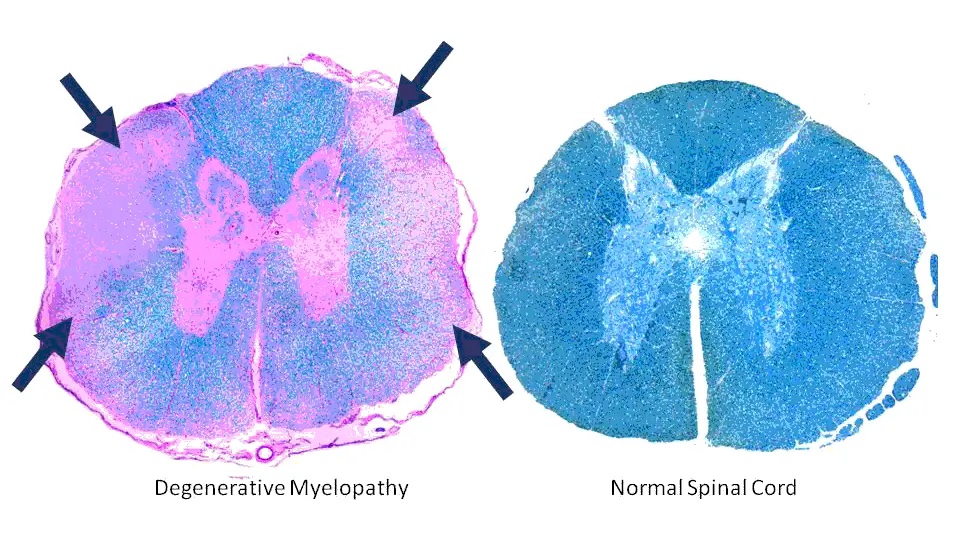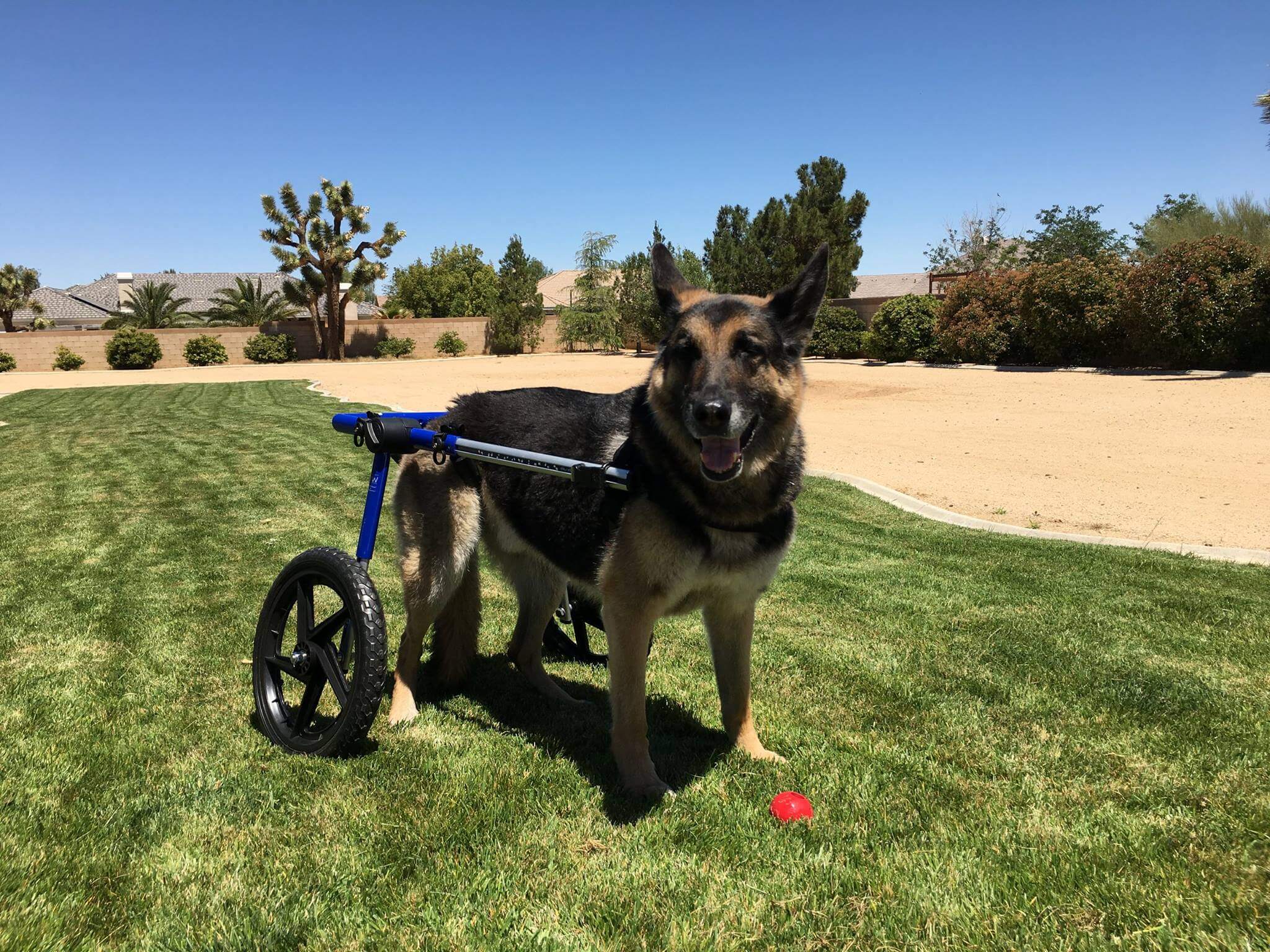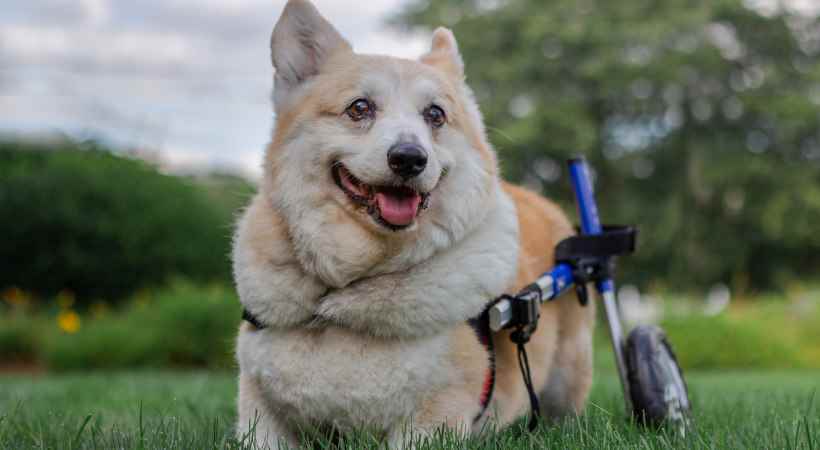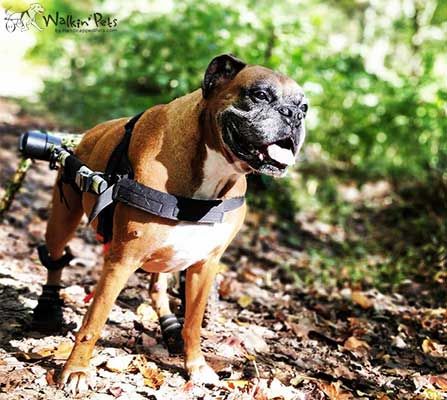 Canine degenerative myelopathy (also known as DM) is a spinal cord disease. It can result in gradual paralysis in dogs, starting in the hind legs and moving toward the front of the body. DM is similar to some forms of ALS (Lou Gehrig’s Disease) and multiple sclerosis in humans. These diseases affect the nerve cells that control movement by destroying the myelin sheath surrounding the nerves and eliminating the nerve’s ability to transmit signals. This then presents as weakness and, eventually, paralysis.
Canine degenerative myelopathy (also known as DM) is a spinal cord disease. It can result in gradual paralysis in dogs, starting in the hind legs and moving toward the front of the body. DM is similar to some forms of ALS (Lou Gehrig’s Disease) and multiple sclerosis in humans. These diseases affect the nerve cells that control movement by destroying the myelin sheath surrounding the nerves and eliminating the nerve’s ability to transmit signals. This then presents as weakness and, eventually, paralysis.
Degenerative myelopathy usually appears in dogs that are middle-aged or older but has been seen in younger dogs, too. The only treatment available for it is physical therapy which, on average, can give most dogs a good two extra years until the owner thinks the dog’s quality of life is no longer high. To date there is no cure for DM but scientists are researching to learn more about the disease and how they might be able to treat it.
The first signs of degenerative myelopathy in dogs can be subtle, like your dog dragging a rear foot, having a wobbly gait, or stumbling. With time, degenerative myelopathy symptoms can progress to swaying, falling to the side, loss of coordination, worn nails on the rear paws, walking on their knuckles, and difficulty getting up.
Eventually, the dog’s rear legs weaken, then become paralyzed. After that, the paralysis moves forward, affecting the front legs until they no longer work, either. Paralysis can continue all the way to your dog’s head but euthanasia is generally recommended before it gets to that point as the lungs can be affected, making breathing difficult.
 Your dog may also be unable to control their ability to urinate or defecate so your rehab professional can teach you how to easily express the bladder and bowels, avoiding having accidents in the house. It’s easy to learn and perform and it puts you in charge of your pet’s elimination schedule.
Your dog may also be unable to control their ability to urinate or defecate so your rehab professional can teach you how to easily express the bladder and bowels, avoiding having accidents in the house. It’s easy to learn and perform and it puts you in charge of your pet’s elimination schedule.
DM seems to be more common in breeds like Corgis, Boxers, and German Shepherds but it can affect almost all breeds. Dogs are often diagnosed with DM when, in fact, they don’t have it. Experts say that only 25% of German Shepherds actually have DM even though they test as a carrier and have symptoms that mimic the disease. Many dogs carry the DM gene but never develop it. Degenerative myelopathy testing is vital to help diagnose and manage the condition effectively. Often, dogs have a quite treatable, non-DM disease so you really want to get your pet examined by a neurologist to rule out other problems.
 Survival time following diagnosis of DM in dogs can vary. Early intervention and degenerative myelopathy treatment with physical therapy, antioxidants, diet to support proper nutrition and the gut microbiome, exercise, Transcutaneous Electrical Nerve Stimulation (TENS), and acupuncture can be critical. Some of the mobility aids we use for dogs diagnosed with DM are wheelchairs and harnesses to support the rear legs or both the front and the back if the dog is having difficulty standing or walking. We also recommend booties to protect the feet from scraping on the ground, causing wounds. We might recommend ramps to help you get your dog in and out of the car. Another important tool is having an orthopedic mattress to protect your dog from bedsores. We also work with you to keep your dog at an appropriate weight as excess weight makes ambulation much more difficult.
Survival time following diagnosis of DM in dogs can vary. Early intervention and degenerative myelopathy treatment with physical therapy, antioxidants, diet to support proper nutrition and the gut microbiome, exercise, Transcutaneous Electrical Nerve Stimulation (TENS), and acupuncture can be critical. Some of the mobility aids we use for dogs diagnosed with DM are wheelchairs and harnesses to support the rear legs or both the front and the back if the dog is having difficulty standing or walking. We also recommend booties to protect the feet from scraping on the ground, causing wounds. We might recommend ramps to help you get your dog in and out of the car. Another important tool is having an orthopedic mattress to protect your dog from bedsores. We also work with you to keep your dog at an appropriate weight as excess weight makes ambulation much more difficult.
The most important factor, though, is consistent daily exercise to strengthen all the muscles in the body. We know that dogs with DM survive much longer with intensive PT and are able to walk significantly longer than dogs who receive no PT. Stem cell transplants are also receiving much interest as a possible tool to help stave off the effects of DM. Intensive laser therapy has also shown to be quite beneficial for longevity.
 And when it comes to the point that your dog’s quality of life has declined so much that they no longer have good days, we can help you with end-of-life decisions. For those wondering about the right time to consider or figure out when to euthanize, we offer compassionate guidance and work with you based on a whole series of decisions regarding your pet’s quality of life. Being a caregiver of a disabled dog is a big chore. You are honoring your commitment to your pet’s well-being. You are showing how much your pet has enriched your life. But you also have to consider your own well-being. If your life revolves around carrying your dog from one room to another, turning them to avoid bedsores, cleaning up after them, staying home so they have ’round-the-clock care, protecting them from getting stuck under furniture, and straining your back to carry and move them, at some point, it might not be healthy or safe for you. We all have our limits. When your QOL has deteriorated to the point of being unhealthy, chances are that your pet's has, too.
And when it comes to the point that your dog’s quality of life has declined so much that they no longer have good days, we can help you with end-of-life decisions. For those wondering about the right time to consider or figure out when to euthanize, we offer compassionate guidance and work with you based on a whole series of decisions regarding your pet’s quality of life. Being a caregiver of a disabled dog is a big chore. You are honoring your commitment to your pet’s well-being. You are showing how much your pet has enriched your life. But you also have to consider your own well-being. If your life revolves around carrying your dog from one room to another, turning them to avoid bedsores, cleaning up after them, staying home so they have ’round-the-clock care, protecting them from getting stuck under furniture, and straining your back to carry and move them, at some point, it might not be healthy or safe for you. We all have our limits. When your QOL has deteriorated to the point of being unhealthy, chances are that your pet's has, too.
DM is a challenging disease, difficult to experience, and difficult to witness. We know that regular exercise, proper weight, and physical therapy are the best tools for optimizing your pet’s quality of life and your own.
